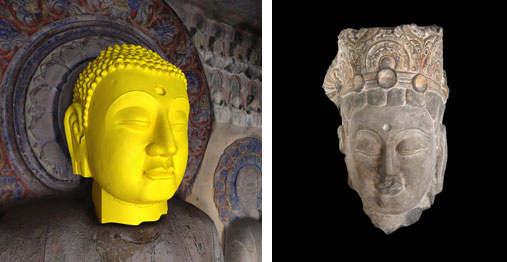“Echoes of the Past: The Buddhist Cave Temples of Xiangtangshan”
Innovative digital components and 3D-imaging technology complement the majestic sixth-century Chinese Buddhist sculptures in “Echoes of the Past: The Buddhist Cave Temples of Xiangtangshan,” on display at the Arthur M. Sackler Gallery through July 31. The exhibition includes a video installation that offers an immersive, kinetic re-creation of one of the earliest and most important Buddhist pilgrimage sites in China. Touch screens and research kiosks give detailed information about the site and the themes explored in the exhibition.

An artist's rendering of the 3D digitally reconstructed north, east and south altars of the South Cave in Northern Xiangtanshan. (Image by Jason Salavon and Travis Saul)
Carved into the mountains of northern China, the Buddhist cave temples of Xiangtangshan (pronounced “shahng-tahng-shahn”) were the crowning cultural achievement of the sixth-century Northern Qi dynasty (550-577 CE). Once home to a magnificent array of sculptures—monumental Buddhas, divine attendant figures and crouching monsters framed by floral motifs—the limestone caves were severely damaged in the first half of the 20th century when their contents were chiseled away and offered for sale on the international art market. The extensive damage to Xiangtangshan makes it nearly impossible for observers to appreciate the original appearance of the caves or to understand the rich and complex artistic and religious achievement they once represented. In recent years, research and new technologies have made it possible to digitally envision some of the caves as they once were.

Left: 3-D digital reconstruction with missing fragment in yellow, image by Jason Salavon and Travis Saul. Right: Head of a Bodhisattva, courtesy of University of Pennsylvania Museum of Archaeology and Anthropology.
Five years ago, researchers at the Center for East Asia at the University of Chicago began examining fragments long thought to have come originally from Xiangtangshan. The fragments, bought and sold decades before international laws prohibited such trade and housed in collections and museums all over the world, were photographed and then scanned using 3D imaging technology.
In order to contextualize the data, the team collaborated with site managers at Xiangtangshan itself to digitally scan the caves as well. “These two scans provide the basis for the virtual reconstruction of the man-made cave temples today,” says Keith Wilson, associate director and curator of ancient Chinese art at the Freer and Sackler galleries. “The sculptures and recreations help complete the picture.”
Xiangtanshan 3-D Model from Smart Museum of Art on Vimeo.
Posted: 27 April 2011
-
Categories:
Art and Design , Asian Art Museum , Feature Stories , History and Culture








